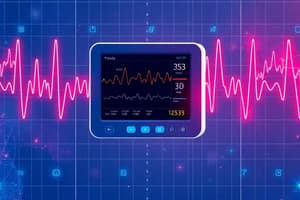Podcast
Questions and Answers
What is the acceptable range for capillary refill time (CRT) in an anesthetized patient?
What is the acceptable range for capillary refill time (CRT) in an anesthetized patient?
- ≤ 2 seconds (correct)
- ≤ 5 seconds
- ≤ 3 seconds
- ≤ 1 second
What is the main function of an anesthetic machine?
What is the main function of an anesthetic machine?
- To deliver oxygen and anesthetic gases (correct)
- To monitor vital signs
- To regulate body temperature
- To monitor blood pressure
What is the acceptable range for heart rate in an anesthetized canine patient?
What is the acceptable range for heart rate in an anesthetized canine patient?
- 100-140 bpm
- 60-100 bpm
- 120-160 bpm
- 80-120 bpm (correct)
What should be done if the pulse oximeter stops functioning or appears incorrect during surgery?
What should be done if the pulse oximeter stops functioning or appears incorrect during surgery?
How often should a patient's vitals be checked and recorded during surgery?
How often should a patient's vitals be checked and recorded during surgery?
What is the primary purpose of a non-rebreather anesthetic tube?
What is the primary purpose of a non-rebreather anesthetic tube?
Which of the following patients may require a longer period of recovery before extubation?
Which of the following patients may require a longer period of recovery before extubation?
What is the term for an adverse reaction to anesthesia that can occur after a dental procedure?
What is the term for an adverse reaction to anesthesia that can occur after a dental procedure?
What is the term for the phenomenon where the anesthetic gases accumulate in the reservoir bag?
What is the term for the phenomenon where the anesthetic gases accumulate in the reservoir bag?
Which of the following forms of recumbency is never acceptable for recovery?
Which of the following forms of recumbency is never acceptable for recovery?
Flashcards are hidden until you start studying
Study Notes
Anesthesia Monitoring Parameters
- Palpebral reflex: present under light anesthesia, absent under deep anesthesia
- Corneal reflex: should be present, absence indicates excessively deep anesthesia
- Jaw tone: varies with anesthetic depth
- Capillary refill time (CRT): ≤ 2 seconds
- Mucous membrane color: light pink to pink and moist
- Peripheral pulses: strong and synchronous
- Pulse oximetry (SpO2): > 95%
- Capnography: ETCO2 35-45 mm Hg
- Blood pressure: mean 70-120 mm Hg, systolic 80-140 mm Hg, diastolic 50-100 mm Hg
- ECG: normal sinus rhythm or respiratory sinus arrhythmia
- Body temperature:
- Canine: 100-101°F (36.1-38.3°C)
- Feline: 100-101°F (36.1-38.3°C)
- Heart rate:
- Canine: 80-120 bpm
- Feline: 100-180 bpm
- Respiration rate: 10-40 per minute
Vital Signs and Monitoring
- Temperature: should be taken every 5-10 minutes during surgery
- Acceptable gum color: pink, blue indicates hypoxia, white indicates shock
- CRT: ≤ 2 seconds, > 2 seconds indicates issue
- SpO2: > 95%, ideal 98-100%
- Heart rate: manually checked every 5 minutes during surgery
- Vitals: checked and recorded every 5 minutes during surgery
- Pulse oximeter malfunction: check connections, ensure proper placement, and troubleshoot equipment
Anesthesia Machine and Equipment
- Anesthesia machine: provides oxygen, anesthetic gas, and scavenging system
- Main function: delivers anesthetic gas to patient
- Non-rebreather tube: used for short procedures, provides fresh gas with each breath
- Leak check: performed before use
- Dead space: volume of gas that is not participating in gas exchange
- Hypotensive: blood pressure < 60 mm Hg, treated with fluids and vasopressors
Recovery and Post-Op Care
- Extubation: safe when patient is responsive, breathing regularly, and able to swallow
- Patients requiring longer recovery: geriatric, obese, or those with pre-existing conditions
- Vomiting during intubation: suction and re-intubate, during extubation: support patient and monitor vital signs
- Acceptable recumbency: lateral, sternal, or dorsal, never ventral
- Reactions to anesthesia: hypoxia, hypercapnia, and hyperthermia, known as anaphylaxis
- Extra reaction to anesthesia after dental procedure: respiratory depression
Medical Terminology
- CRT: capillary refill time
- MM: mucous membrane
- SpO2: pulse oximetry
- bpm: beats per minute
- IM: intramuscular
- SQ or SC: subcutaneous
- NPO: nothing by mouth
- BP: blood pressure
- Capnograph: measures end-tidal CO2
- Iso: isoflurane
- Bx: biopsy
- Sz: seizure
- Fx: fracture
- CPR: cardiopulmonary resuscitation
- Hx: history
- FNA: fine needle aspirate
- F-Circuit: circle system anesthesia circuit
- Reservoir Bag: part of anesthesia machine
- ETT: endotracheal tube
- Waste gases: scavenged gases
- Dehiscence: wound rupture
- Auscultation: listening to heart and lung sounds
- CHF: congestive heart failure
- CRI: constant rate infusion
- IOE: intraoperative euthanasia
- IVC: intravenous catheter
- IVF: intravenous fluid
- Target Pattern: desired anesthetic depth
- IP: intraperitoneal
- IO: intraosseous
- PO: per os
- LRS: lactated Ringer's solution
- NaCl: sodium chloride
- Rx: prescription
- R/O: rule out
- Px: prognosis
- Scavange system: removes waste gases
- Murmur: abnormal heart sound
- Arrhythmia: abnormal heart rhythm
- Thrill: palpable vibration
- Cx: cervix
- Idiopathic: unknown cause
- TD: tetanus and diphtheria
- OHE: ovariohysterectomy
Studying That Suits You
Use AI to generate personalized quizzes and flashcards to suit your learning preferences.




